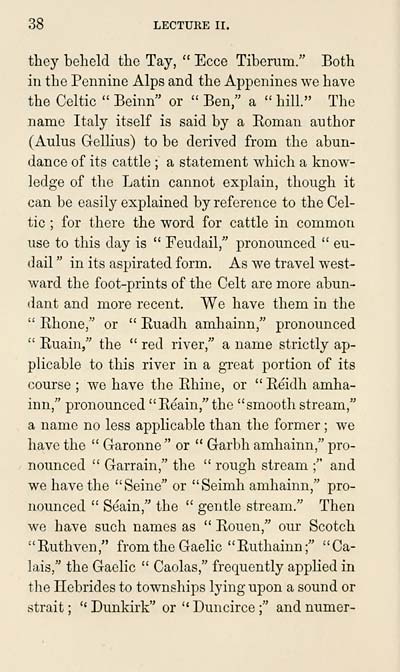Blair Collection > Celtic gleanings, or, Notices of the history and literature of the Scottish Gael
(50)
Download files
Complete book:
Individual page:
Thumbnail gallery: Grid view | List view

38 LECTURE II.
they beheld the Tay, " Ecce Tibemm." Both
in the Pennine Alps and the Appenines we have
the Celtic " Beinn" or '' Ben/' a " hill." The
name Italy itself is said by a Roman author
(Aulus Gellius) to be derived from the abun-
dance of its cattle ; a statement which a know^-
ledge of the Latin cannot explain, though it
can be easily explained by reference to the Cel-
tic ; for there the word for cattle in common
use to this day is " Feudail/' pronounced " eu-
dail " in its aspirated form. As we travel west-
ward the foot-prints of the Celt are more abun-
dant and more recent. We have them in the
" Rhone/' or " Ruadh amhainn/' pronounced
'' Ruain/' the " red river/' a name strictly ap-
plicable to this river in a great portion of its
course ; we have the Rhine, or *' Reidh amha-
inn," pronounced "Reain," the "smooth stream,"
a name no less applicable than the former ; we
have the " Garonne " or " Garbh amhainn," pro-
nounced " Garrain," the " rough stream /' and
we have the "Seine" or "Seimh amhainn," pro-
nounced " Seain," the " gentle stream." Then
we have such names as " Rouen," our Scotch
' ' Ruthven /' from the Gaelic ' ' Ruthainn /' "Ca-
lais," the Gaelic " Caolas/' frequently applied in
the Hebrides to townships lying upon a sound or
strait ; '' Dunkirk" or " Duncirce /' and numer-
they beheld the Tay, " Ecce Tibemm." Both
in the Pennine Alps and the Appenines we have
the Celtic " Beinn" or '' Ben/' a " hill." The
name Italy itself is said by a Roman author
(Aulus Gellius) to be derived from the abun-
dance of its cattle ; a statement which a know^-
ledge of the Latin cannot explain, though it
can be easily explained by reference to the Cel-
tic ; for there the word for cattle in common
use to this day is " Feudail/' pronounced " eu-
dail " in its aspirated form. As we travel west-
ward the foot-prints of the Celt are more abun-
dant and more recent. We have them in the
" Rhone/' or " Ruadh amhainn/' pronounced
'' Ruain/' the " red river/' a name strictly ap-
plicable to this river in a great portion of its
course ; we have the Rhine, or *' Reidh amha-
inn," pronounced "Reain," the "smooth stream,"
a name no less applicable than the former ; we
have the " Garonne " or " Garbh amhainn," pro-
nounced " Garrain," the " rough stream /' and
we have the "Seine" or "Seimh amhainn," pro-
nounced " Seain," the " gentle stream." Then
we have such names as " Rouen," our Scotch
' ' Ruthven /' from the Gaelic ' ' Ruthainn /' "Ca-
lais," the Gaelic " Caolas/' frequently applied in
the Hebrides to townships lying upon a sound or
strait ; '' Dunkirk" or " Duncirce /' and numer-
Set display mode to: Large image | Transcription
Images and transcriptions on this page, including medium image downloads, may be used under the Creative Commons Attribution 4.0 International Licence unless otherwise stated. ![]()
| Early Gaelic Book Collections > Blair Collection > Celtic gleanings, or, Notices of the history and literature of the Scottish Gael > (50) |
|---|
| Permanent URL | https://digital.nls.uk/76269294 |
|---|
| Description | A selection of books from a collection of more than 500 titles, mostly on religious and literary topics. Also includes some material dealing with other Celtic languages and societies. Collection created towards the end of the 19th century by Lady Evelyn Stewart Murray. |
|---|
| Description | Selected items from five 'Special and Named Printed Collections'. Includes books in Gaelic and other Celtic languages, works about the Gaels, their languages, literature, culture and history. |
|---|

